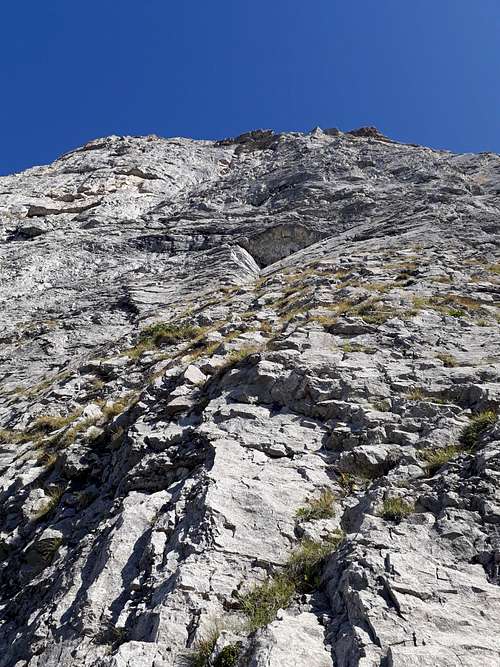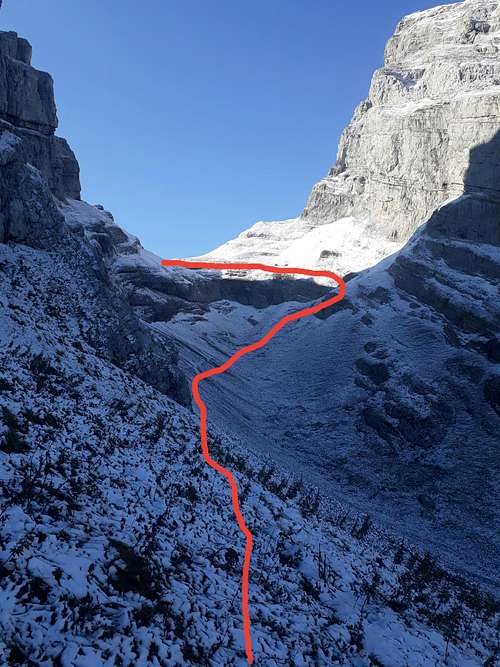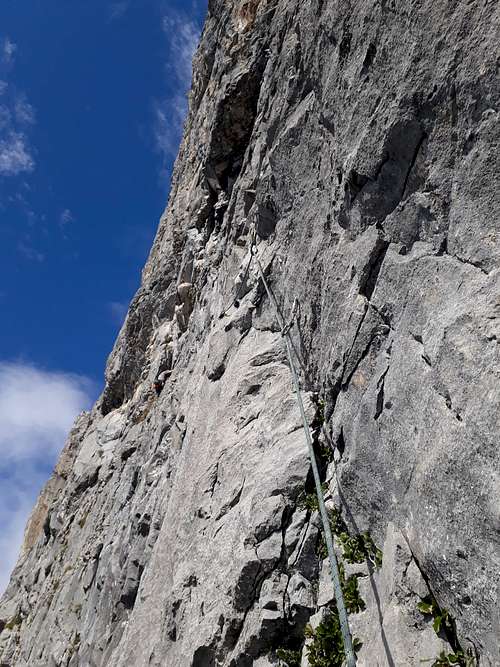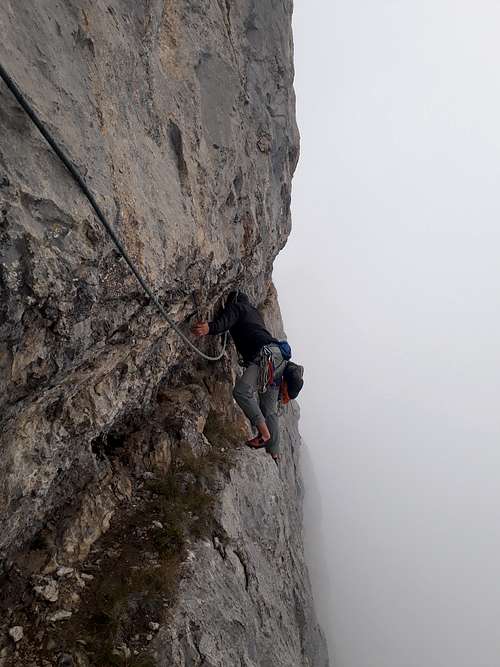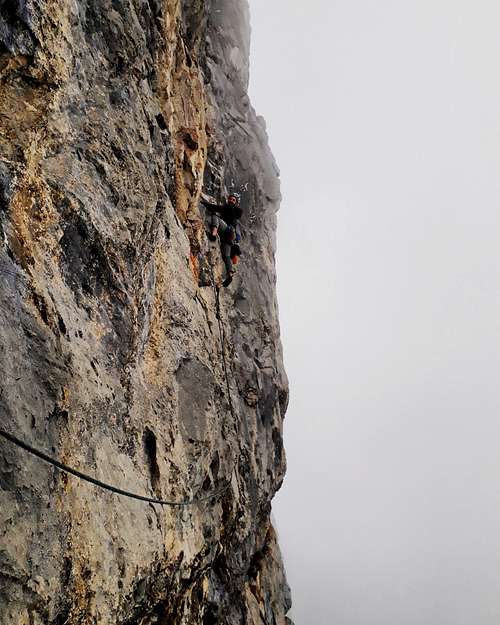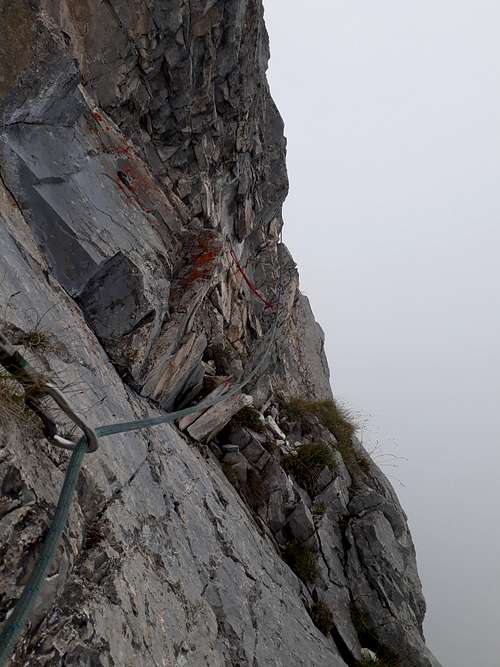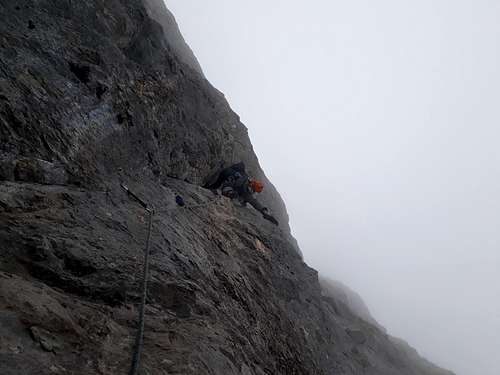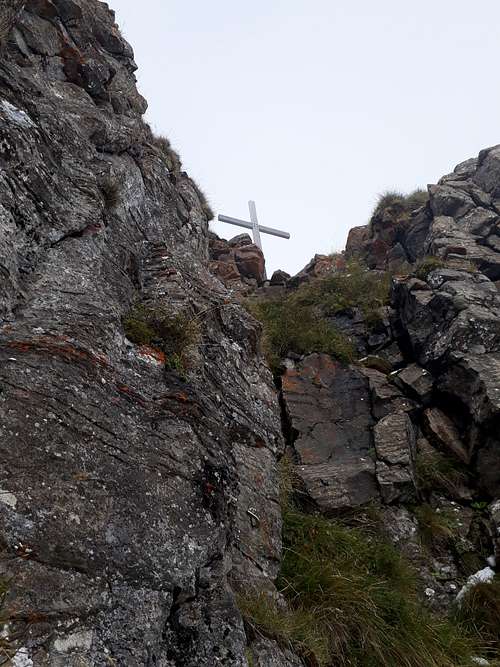-
 1705 Hits
1705 Hits
-
 76.66% Score
76.66% Score
-
 7 Votes
7 Votes
|
|
Route |
|---|---|
|
|
47.15440°N / 9.28550°E |
|
|
Sport Climbing, Big Wall |
|
|
Summer, Fall |
|
|
Most of a day |
|
|
5.11a (YDS) |
|
|
11 |
|
|
III |
|
|
Overview
The Neue Süd (first ascent 1982) route takes an adventurous, wandering path up the left side of the intimidating 300 meter (~1000 feet) tall south face of Zuestoll, above Walenstadt and the Walensee. Though many of these limestone walls in this area appear quite chossy, the south face of the Zuestoll is generally quite solid, and the rock very sharp. With that said, there are still some spots on the route with a bit of loose rock. I label this climb as a sport climb, however don't expect a simple clip up; while all cruxes feature closely placed bolts (french free-able), there is some runout terrain, particularly on traverses where the follower should be as solid as the leader. You can eliminate some, but not all, of the runouts by bringing a few cams and nuts. All anchors are bolted, and all of the bolts are solid (bolts replaced with excellent hardware in early 2010s). With a 70 meter rope, it is possible to combine pitches to bring the pitch count down to 8. The route is pretty sustained and has decent climbing on most pitches. This makes a very good day outing for those who feel up to it; the approach is not too strenuous, the trailhead is one hour from Zurich, and the views are top notch. It's worth noting again that there is some loose rock in some spots, so a helmet is strongly advised. A direct summit top out and mellow walk-off descent add to the quality of the route.
Getting There
The approach takes about 1.5 to 2 hours and is very scenic and exposed. From Alp Sellamatt follow blue and white marked signs towards the obvious base of the north side of Zuestoll. The trail briefly climbs up a small "valley" and climbs out of it via class 3 ledges and metal steps bolted into the rock. Before the trail begins to climb up onto the Zuestoll proper, take a faint climber's trail to the right, towards Paliis Nideri (the pass/col between Zuestoll and Brisi). Follow the faint trail and occasional cairn up the large valley in between the Brisi and Zuestoll. Once you reach Paliis Nideri, you are all of the sudden on top of a very steep, exposed slope with a jaw dropping view. Turn left and follow flat but thin grassy ledges around the corner (don't slip) to some fixed ropes that lead to a large grassy shelf. You'll see some nice shiny bolts going straight up. This is the approach pitch to the base of the wall and start of the route.
Route Description
Pitch 1: Follow the line of bolts straight up the grassy ledgey stuff. 5.7 35 meters.
Pitch 2: First traverse of the route; don't worry, there will be plenty more to come! From the bolted anchor at the top of the first pitch, traverse straight left to a bolt at an exposed stance. Make an easy 5.11 move and traverse up and left to find a bolted anchor. You don't gain too much vertical on this pitch. 5.11a 25 meters.
Pitch 3: From the belay, traverse left some more and climb a steep but juggy left facing dihedral to a ledge and another bolted anchor. 5.9 25 meters.
Pitch 4: Second crux. From the belay, follow the left-hand line of bolts with tricky climbing. Find the beginning of the leftward traverse and follow the bolts to an anchor (serious swing potential for the second). The traverse on this pitch is tricky to negotiate; the bolts are never too hard to follow, but are in odd spots, requiring some unconventional movement. 5.11a 30 meters.
Pitch 5: Follow more bolts up and left. Duck under a large protrusion of stone, turning it on the left side, and climb up steep and engaging terrain to a comfortable enough belay ledge. 5.10c 30 meters.
Pitch 6: Climb a straightforward left facing dihedral to an anchor on a ledge. 5.9 15 meters.
Pitch 7: Third crux. Make a difficult move off the ledge into the left facing corner above, and climb ever steepening, difficult moves on tiny sharp holds. Belay at a marginal stance at an anchor. This pitch might be the crux of the route. 5.11a 25 meters.
Pitch 8: Traverse right along the exposed ledge; it's not too hard, just awkward. A belly crawl may even be in order. Clip the two bolts at the end of the traverse with long slings and perform steep but solid moves on big holds straight up to a broken ledge. Here you'll find an anchor as well as the register book (not sure why it's placed there, there are still three pitches of climbing above!) 5.10b 30 meters.
Pitch 9: Quality pitch, despite the looks of the start of it. Traverse easy but loose rock to the right and make a crazy move out onto the much more solid headwall (wild exposure here!). Enjoy not too difficult climbing on great quality limestone up to a grassy ledge. 5.10a 30 meters.
Pitch 10: Last difficult pitch. Climb the obvious arcing, right facing corner, following bolts up to a good ledge. 5.10c 30 meters.
Pitch 11: Summit pitch. Climb up grass past 3 or 4 good bolts and top out at the summit cross. 5.grass 35 meters.
Descent is via the trail off the summit, which has got some fourth class on the way down.
Essential Gear
We climbed this in 8 pitches with a single 70 meter rope, combining pitch numbers 2 & 3, 4 & 5, and 6 & 7. Rope drag was an issue sometimes but doing this sped up the climb significantly. Trying to do this with a 60 meter rope might work but could turn into some serious rope stretchers. You may also consider using half ropes because of the wandering nature of the climb.
For gear, about 15 draws should suffice (with a healthy amount of extendables, and double length slings even). If you want to eliminate some of the runouts, one cam each from .4 to .75 Black Diamond or equivalent and some nuts would be plenty, but they are optional.
The route gets full sun exposure. Here is a useful Topo (in German).


